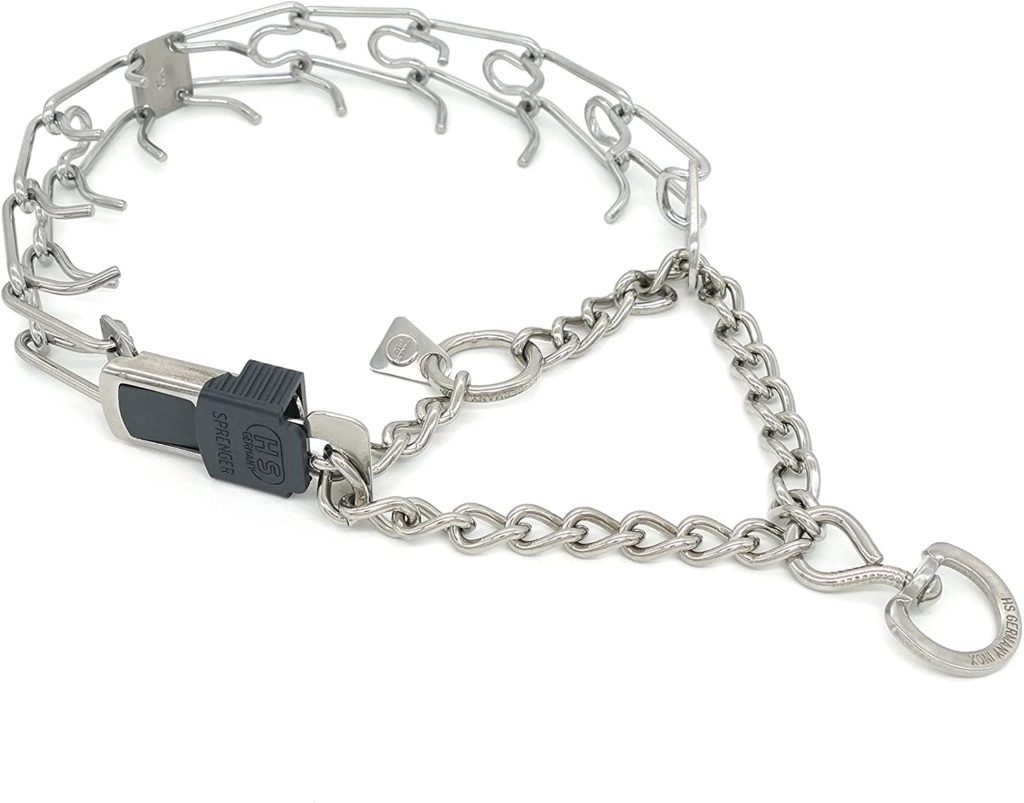There is almost nothing more dangerous than an out-of-control giant breed dog. Good leash skills are one of the most important things that you can teach your Great Dane! If you are ready to learn how to teach a Great Dane to walk on a leash, read on.
Don’t worry, it’s not as difficult as it sounds. With a little patience and some positive, thoughtful balanced dog training, you’ll have your Dane walking nicely on a leash in no time. Here’s what you need to know.

Step One – Teach Your Great Dane to Walk on a Leash 101
Step one: start with basic obedience commands like sit, look (at me), and touch (the palm of your hand).
You’ll need to have these commands taught at a basic level before you can move on to really teaching your dog how to walk on a leash. All of these skills are easy to teach using positive reinforcement!
What is the Best Leash for Great Danes?
Great Dane Fail: Off Leash and Out of Control
3 Tips for Leash Training Great Danes
Use lots of rewards. This helps your Dane build confidence and will help you install correct behaviors (which will come in handy if your Great Dane pulls a lot when you leave the house)!
You’ll notice a massive difference in your dog if you practice these skills even just 5-10 minutes each day.
Be consistent with your commands and rewards – always praise and treat your dog when they follow your instructions

Leash Walking Basics: Teach Focus and “With Me”
In this stage, you will work with your dog off-leash in your home or in a fenced yard.
If you don’t have space for safe off-leash work, use a long leash and an ergonomic harness (we do not recommend using ‘Petsafe’ or ‘Easy Walk’ no-pull harnesses on Great Danes).
Use lots of treats and with your Great Dane on the left side, take a step. Praise, treat and repeat.
Practice this until you can walk 10 steps or more between rewards. Add obstacles such as cones or balls, too, and practice walking around them together. Reward your dog for engaging with you!
Gradually introduce the leash, making sure to keep the training positive and upbeat.
Keep the leash loose in your hands. It is only there for safety.
We like a basic slip lead or a martingale collar + leather leash.

HOW TO TRAIN A GREAT DANE TO BE CALM
Many people struggle in this step of teaching focus, engagement, and calm behavior in all environments.
You may notice that your Great Dane does AMAZING with these leash training exercises when you are at home, but when you go somewhere new they forget everything that you’ve taught them!
Here are some tips for teaching your Great Dane to be calm in ALL environments:
- Use structure and routines at home to encourage ‘calm’ settling behavior
- Teach a ‘place’ command and build this skill up until you can say ‘place’ and expect your dog to settle there, no matter what
- Make sure your Great Dane is getting enough physical and mental enrichment! The world is much less exciting to a dog that is satisfied. Proper enrichment will reduce anxiety, boredom, and the frustrating behaviors that result from not getting enough. (Read our blog post on bored Great Danes! and also the best toys for Great Danes)

Practice Leash Walking
Now it’s time to increase the difficulty! You’ll want to work on your leash skills in a variety of places with varying distractions.
Start off slowly, with just a few minutes of walking at first. Gradually increase the amount of time you spend walking together as your dog gets more comfortable ignoring the world and focusing on YOU.
When you encounter a distraction, ask your dog to engage with you and continue moving.
Continue to use a lot of positive reinforcement! This is how you teach your dog the correct behavior and increase the chance that they will repeat the behavior that you want.

THE BEST LEASH FOR GREAT DANES
We recommend that all Great Dane owners have three leashes:
1. A good long Biothane leash (for off-leash training and being in places where being off-leash is not legal)
2. A leather leash with a sturdy clip for everyday use and walking with a flat collar, martingale, headcollar, or prong collar
3. A leather slip lead for ease of use, training, and safety (slip leads are escape-proof!)

How Do I Stop My Great Dane From Pulling?
We recommend that all Great Danes who pull revisit leash walking 101, outlined above.
GREAT DANE TRAINING TOOLS
We recommend the use of well-fitted Herm Sprenger Prong Collars for Great Danes that pull.
Prong collars are commonly used for Great Danes, but it is important to use them correctly. If you’re not sure how to use a prong collar, ask a highly qualified positive-balanced dog trainer for help.
Herm Springer is the ONLY brand worth buying; they cost more but they are built correctly and created with rounded edges so that your dog feels evenly distributed pressure, NOT pain during use.
We recommend the use of a wide, flat martingale collar for most Great Danes.
A properly used prong collar, introduced with lots of positive reinforcement can be implemented in a way that is less harmful, less frustrating, less aversive, and safer for you and your Great Dane than a flat collar, ‘no-pull’ harness, choke chain or head collar.
E-Collar Training for Great Danes
Modern E-Collars are introduced in a positive way and use muscle stimulation as a communication (not sharp static ‘shock’). When used and conditioned properly, E-Collars from E-Collar Technologies can be an amazing and helpful tool for off-leash work AND developing better on-leash skills.
E Collar Training Guide
E Collar Myths
What is an E Collar?
What is the Difference Between an E Collar and a Shock Collar?
9 Reasons to E Collar Train Your Great Dane Puppy
We use and recommend only E-Collar Technologies.
You can purchase a mini-educator E-Collar for your Great Dane HERE.

Should I Use a Harness for my Great Dane?
Harnesses have their place, however, for most Great Danes they are the wrong choice.
The only appropriate harness to buy for a Great Dane will have a y-front on it.
All other harnesses (including those marketed as ‘No-Pull’ such as the ‘Freedom’ or ‘Easy-Walk’ harness) work by squeezing the shoulders, throwing the dog off-balance, and restricting movement.
Is the Gentle Leader an Abusive Tool?
No-pull (front clip) harnesses are NOT good training tools for Great Danes. They rely on physical restraint and restrictions to movement that can be damaging to their shoulders, chest and gait.
Just because it’s made of ‘nylon’ doesn’t mean it’s a ‘positive’ or ‘humane’ tool.
One big problem with choosing a y-front harness for your Great Dane is that if your Great Dane were to pull you, they have a ton of leverage to do so.
A proper Y-front harness should be used with a long leash and only with dogs that do NOT pull, lunge or react. We recommend the RUFFWEAR FRONT RANGE HARNESS.

Off-Leash Obedience for Great Danes
We believe that all Great Danes should also be reliably off-leash trained. Good off-leash skills translate to great on-leash skills!
Reducing the reliance on a leash and collar for every activity is much healthier for them from a physical and mental enrichment standpoint, too.
Off-leash dogs cannot damage their gait, neck, or head by lunging into collars, harnesses, or ‘Gentle Leaders’. They also get to experience the freedom of movement which is very enriching to them.
For more information about off-leash training, visit our E-Collar and off-leash obedience category!










2 Responses
I am a pet sitter. I walk different types of dogs. I have a great Dane, who is not even a year old who pulls me down. They’re now using a harness. But I looked into using either a choker collar or a slip collar. What would you recommend? Thank you for your time the dog is not trained at all. I recommended a trainer. She has not gotten one the only walk the dog gets is my mid day walk. But it’s getting more and more difficult for me. Lisa.
Hi Lisa! Thanks for reaching out – gosh yeah that sounds difficult, especially since this isn’t your dog and they don’t seem to be taking your recommendations.
I 100% agree this dog needs a trainer, and that harness is going to become dangerous to you and others. For a dog like this, I’m a big fan of a prong collar + training, HOWEVER, I would only recommend doing that with a trainer. Don’t add a prong collar unless they are willing to allow a trainer to help.
So next best would be a martingale collar; if you get a wide flat one with NO plastic buckle (like this one: https://amzn.to/3Qfug8U) it will be escape proof and give you a little more control.
Then, make sure you are using a sturdy 6-8 foot leash and give the dog some slack. Instead of going on a walk, stand in one place in a boring location. Let the dog sniff around, then add a little pressure to the leash and when the dog responds to the pressure and turns towards you, say YES and offer lots of praise (or a treat if allowed). Do this game often. Reward the dog for releasing leash tension and coming back to you. With enough repetition, you’ll find that she immediately responds to leash pressure by releasing it (instead of pulling into it).
Then in the same area (boring place), lure her to your side then reward. Take a step, reward. Two steps, reward. Teach her that walking next to you = lots of rewards! With time on this, you can move farther distances together and walk more places.
Ideally, they hire a trainer and help this dog learn better skills as well as how to be off-leash (so she can move naturally), but hopefully these tips help bridge the gap until then.
Send them to our blog! We are big advocates for ethical and responsible Great Dane care. A midday walk on a leash in a harness while pulling everywhere definitely needs to be addressed.
Hope that helps!